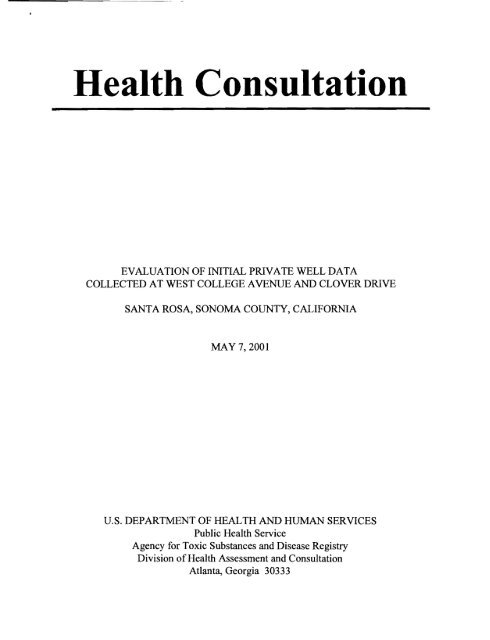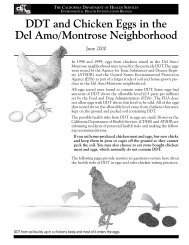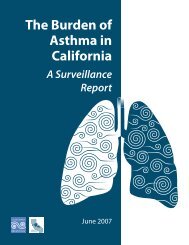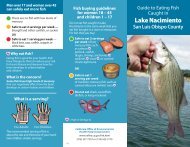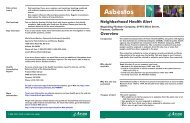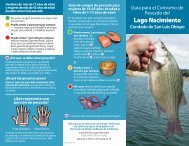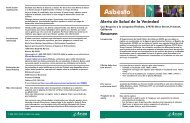Health Consultation - Environmental Health Investigations Branch
Health Consultation - Environmental Health Investigations Branch
Health Consultation - Environmental Health Investigations Branch
You also want an ePaper? Increase the reach of your titles
YUMPU automatically turns print PDFs into web optimized ePapers that Google loves.
<strong>Health</strong> <strong>Consultation</strong> <br />
EVALUATION OF INITIAL PRIVATE WELL DATA <br />
COLLECTED AT WEST COLLEGE AVENUE AND CLOVER DRIVE <br />
SANTA ROSA, SONOMA COUNTY, CALIFORNIA <br />
MAY 7, 2001 <br />
U.S. DEPARTNIENT OF HEALTH AND HUMAN SERVICES <br />
Public <strong>Health</strong> Service <br />
Agency for Toxic Substances and Disease Registry <br />
Division of<strong>Health</strong> Assessment and <strong>Consultation</strong> <br />
Atlanta, Georgia 30333
<strong>Health</strong> <strong>Consultation</strong>: A Note of Explanation<br />
An ATSDR health consultation is a verbal or written response from A TSDR to a specific request<br />
for information about health risks related to a specific site, a chemical release, or the presence of<br />
hazardous material. In order to prevent or mitigate exposures, a consultation may lead to specific<br />
actions, such as restricting use of or replacing water supplies; intensifying environmental<br />
sampling; restricting site access; or removing the contaminated materiaL<br />
In addition, consultations may recommend additional public health actions, such as conducting<br />
health surveillance activities to evaluate exposure or trends in adverse health outcomes;<br />
conducting biological indicators ofexposure studies to assess exposure; and providing health<br />
education for health care providers and community members. This concludes the health<br />
consultation process for this site, unless additional information is obtained by ATSDR which, in<br />
the Agency's opinion, indicates a need to revise or append the conclusions previously issued.<br />
You May Contact ATSDR TOLL FREE at <br />
1-888-42ATSDR <br />
or <br />
Visit our Home Page at: http://www.atsdr.cdc.gov
HEALTH CONSULTATION<br />
EVALUA TION OF INITIAL PRIVATE WELL DATA <br />
COLLECTED AT WEST COLLEGE AVENUE AND CLOVER DRIVE <br />
SANTA ROSA, SONOMA COUNTY, CALIFORNIA <br />
Prepared by: <br />
California Department of <strong>Health</strong> Services <br />
Under Cooperative Agreement with the <br />
Agency for Toxic Substances and Disease Registry
Summary<br />
In September 2000, the <strong>Environmental</strong> <strong>Health</strong> <strong>Investigations</strong> <strong>Branch</strong> (EHIB) of the California<br />
Department of <strong>Health</strong> Services (CDHS), was asked by the North Coast Regional Water Quality<br />
Control Board (NCRWQCB) to address the potential health impact of private well contamination<br />
from the West College Avenue at Clover Drive PCE (tetrachloroethylene) plume, in Santa Rosa,<br />
California. In January 2001, at the request of community members, CDHS sent a letter to the<br />
Slate Water Resources Control Board (SWRCB) in support of funding for health outreach<br />
activities in the impacted community. The content of the correspondence between the<br />
NCRWQCB, the SWRCB and CDHS is the basis'of this health consultation (Appendix A:<br />
September 2000 and January 2001 Letters). CDHS has a cooperative agreement with the federal<br />
Agency for Toxic Substance and Disease Registry (ATSDR), and this health consultation is being<br />
forwarded to ATSDR for their concurrence.<br />
Background and Statement of Issues<br />
The West College at Clover Drive community is located approximately 50 miles north of San<br />
Francisco, in an unincorporated area in the City of Santa Rosa, within Sonoma County,<br />
California. PCE contamination was detected in wells north of West College Avenue in 1995. The<br />
NCRWQCB began investigating the West College and Clover Avenue PCE plume in December<br />
1999 after learning of contamination in a private well south of West College Avenue. In<br />
December 1999, and January 2000, NCRWQCB staff conducted a well survey in the West<br />
College/Clover Drive area to gain an understanding of private well use. The NCRWQCB<br />
determined that there are approximately 98 parcels served by private wells. This area (south of<br />
West College) falls within the "county island", an unincorporated portion of Santa Rosa, with no<br />
current access to municipal water supplies. In August 2000, after obtaining emergency funds<br />
from the State Water Resources Control Board, NCRWQCB staff began sampling private wells.<br />
At that time, approximately 40 wells had been sampled. Initial sampling results from five wells<br />
revealed concentrations of PCE up to 306 parts per billion (ppb). Subsequent sampling revealed<br />
levels up to 576 ppb. The maximum contaminant level (MCL) allowable in municipal water<br />
supplies is 5 ppb. NCR WQCB staff distributed information in the community about the<br />
contamination, and recommended that an alternative water source (bottled water or treatment<br />
system) be used. In September and October 2000, CDHS staff conducted community outreach<br />
and provided health education about PCE and exposure reduction.<br />
In November 2000, the NCRWQCB began installing well head treatment systems on<br />
contaminated wells in areas where there is no access to a municipal water supply. Residents who<br />
live on West College Avenue were able to be connected to the City of Santa Rosa's municipal<br />
water supply.<br />
1
In January 2001, the NCRWQCB received $100,000 from the SWRCB for health outreach<br />
activities in the West College Avenue and Clover Drive community. These activities are being<br />
carried out by Sonoma County Department of <strong>Health</strong> Services, <strong>Environmental</strong> <strong>Health</strong> Division,<br />
with support from CDHS.<br />
Discussion<br />
Evaluation of<strong>Health</strong> Impact:<br />
In September 2000, CDHS staff reviewed private well data provided to us by the NCRWQCB to<br />
determine if the levels of PCE in private drinking water wells pose an immediate health hazard to<br />
residents.<br />
CDHS evaluated non-cancer health effects from exposure to PCE contaminated well water. Noncancer<br />
health effects were evaluated relative to ATSDR health comparison values. We estimated<br />
an exposure dose from ingestion and inhalation for an adult and a child using a private well with<br />
the highest level (306 ppb) of PCE detected at that time (Appendix A: September 2000 Letter).<br />
CDHS assumed that the inhalation dose was equal to the dose received through ingestion. This<br />
assumption is based on a number studies which indicate inhalation exposure to VOC (volatile<br />
organic compound) contaminated water may be as great or greater than exposure from ingestion<br />
alone [1]. Thus, we used the estimated dose calculated for ingestion as a representation of the<br />
inhalation dose. The estimated exposure for a young child (0.04 milligrams per kilograms per day<br />
(mg/kg/day)) approaches acute health standards (Minimal Risk Level (MRL)) for non-cancer<br />
health effects [2]. An acute exposure is considered to be 1-14 days in duration. The acute MRL is<br />
based on a developmental study which showed increased motor behavior (hyperactivity) at an<br />
exposure level of 5 mglkg/day [2]. Additionally, these levels exceed the USEPA MCL of 5ppb,<br />
which is set to be protective over a lifetime of exposure. CDHS concluded that immediate steps<br />
should be taken to eliminate exposures of this magnitude.<br />
Based on our review of the initial data, and the fact that it is likely that exposures occurred for a<br />
number of months if not years, young children are most at risk for non-cancer health effects.<br />
However, since the NCRWQCB has taken measures to eliminate exposures, non-cancer health<br />
effects are not likely to occur.<br />
<strong>Health</strong> Outreach Activities:<br />
Since September 2000, CDHS staff have conducted health outreach activities in the community,<br />
which have included the following: attended several neighborhood meetings; gone door to door<br />
and provided health and exposure reduction information relating to PCE; presented health<br />
information at a large public meeting held by the NCRWQCB; and provided individual<br />
consultation with community members.<br />
2
Based on the outreach efforts conducted by CDHS, and ongoing community health concerns,<br />
NCRWQCB staff recognized the need for continued health outreach in the community. While<br />
Sonoma County <strong>Environmental</strong> <strong>Health</strong> Division is the agency charged with carrying out these<br />
types of activities, limited resources and lack of expertise at the county level was prohibiting the<br />
development and implementation of such a process. In December 2000, the NCRWQCB<br />
requested $100,000 from the SWRCB to fund Sonoma County Department of <strong>Health</strong> Services in<br />
developing a process for health outreach, while at the same time building capacity within their<br />
agency. CDHS was asked by community members to write a letter to SWRCB supporting the<br />
request for funding (Appendix A: January 2001 Letter).<br />
On January 10,2001, CDHS staff attended the SWRCB hearing and expressed support for the<br />
funding of health outreach activities. Several community members also spoke at the hearing,<br />
urging the board to allocate the funds. The SWRCB awarded $100,000 for health outreach<br />
activities in the community. The award was somewhat unprecedented as the SWRCB deals<br />
primarily with cleanup issues relating to water, not health outreach. CDHS will continue to<br />
provide support to Sonoma County and the NCRWQCB in the development and implementation<br />
of a health outreach plan in the West College Avenue and Clover Drive community.<br />
Children's <strong>Health</strong> Issues<br />
CDHS and ATSDR recognize that children can be more sensitive to health effects caused by<br />
environmental contaminants, and believe that it is important to search for additional information<br />
that will increase our understanding of the contaminants, and ensure that the children's health is<br />
protected. Thus, our correspondence to the NCRWQCB focused on the exposure a child may<br />
receive.<br />
Conclusion<br />
Based on initial sampling results, CDHS has determined that PCE levels measured in some of the<br />
private wells approached acute MRL's for non-cancer health effects. CDHS recommended that<br />
immediate steps be taken to eliminate exposures from impacted wells. The NCRWQCB<br />
implemented well head treatment systems on impacted wells, and connected residents to<br />
municipal water where available.<br />
Due to the high level of community health concerns, a need for continued health outreach in the<br />
community was identified. Future health outreach activities will be developed and carried out by<br />
Sonoma County <strong>Environmental</strong> <strong>Health</strong>, with assistance from CDHS.<br />
Public <strong>Health</strong> Recommendations and Actions<br />
The Public <strong>Health</strong> Recommendations and Actions Plan (PHRAP) for this site contain a<br />
description of actions taken. to be taken, or under considerations by ATSDR and CDHS at and<br />
near the site. The purpose of the PHRAP is to ensure that this health consultation not only<br />
3
identifies public health hazards, but also provides a plan of action designed to mitigate and<br />
prevent adverse human health effects resulting from exposures to hazardous substances in the<br />
environment. The CDHS and ATSDR will follow-up on this plan to ensure that actions are<br />
carried out.<br />
Actions Completed<br />
1. September 2000, CDHS responded to the NCRWQCB's request for technical assistance.<br />
2. September-October 2000, CDHS conducted health outreach and education in the<br />
impacted community.<br />
3. January 2001, CDHS responded to community requests to support funding for continued<br />
health outreach by speaking at the SWRCB hearing and writing a letter of support.<br />
Ongoing Actions<br />
1. CDHS will provide technical resources and support to Sonoma County Department of<br />
<strong>Health</strong> Services, <strong>Environmental</strong> <strong>Health</strong> Division, in the development and implementation<br />
of a health outreach plan.<br />
2. CDHS will provide technical assistance to the NCRWQCB, as needed.<br />
3. CDHS will provide individual consultation to residents in the West College A venue and<br />
Clover Drive community.<br />
4. CDHS will continue to keep community members aware of the CDHS and ATSDR<br />
activities in the West College Avenue and Clover Drive community.<br />
Recommendations for Further Actions<br />
L<br />
CDHS/ATSDR recommend that Sonoma County <strong>Environmental</strong> <strong>Health</strong> explore avenues<br />
to identify other "county islands" served by private wells, which potentially may be<br />
impacted by industrial sources and provide education relating to sampling and safety of<br />
private well use.<br />
4
Preparers of Report<br />
<strong>Environmental</strong> and <strong>Health</strong> Effects Assessors:<br />
Tracy Barreau, R.E.H.S.<br />
Research Specialist<br />
Impact Assessment contractor to the<br />
<strong>Environmental</strong> <strong>Health</strong> <strong>Investigations</strong> <strong>Branch</strong><br />
California Department of <strong>Health</strong> Services<br />
Marilyn C. Underwood, Ph.D.<br />
Staff Toxicologist<br />
<strong>Environmental</strong> <strong>Health</strong> <strong>Investigations</strong> <strong>Branch</strong><br />
California Department of <strong>Health</strong> Services<br />
Tivo Rojas, M.P.H.<br />
Community <strong>Health</strong> Educator<br />
<strong>Environmental</strong> <strong>Health</strong> <strong>Investigations</strong> <strong>Branch</strong><br />
California Department of <strong>Health</strong> Services<br />
ATSDR Regional Representatives:<br />
William Nelson<br />
Gwen Eng<br />
Regional Representatives, Region IX<br />
Agency for Toxic Substances and Disease Registry<br />
ATSDR Technical Project Officer:<br />
Tammie McRae, M.S.<br />
<strong>Environmental</strong> <strong>Health</strong> Scientist<br />
Division of <strong>Health</strong> Assessment and <strong>Consultation</strong><br />
Superfund Site Assessment <strong>Branch</strong>, State Programs Section<br />
5
Certification<br />
The Evaluation of Private Well Water Data Collected at West College Avenue and Clover Drive<br />
<strong>Health</strong> <strong>Consultation</strong> was prepared by the California Department of <strong>Health</strong> Services under a<br />
cooperative agreement with the Agency for Toxic Substances and Disease Registry (ATSDR). It<br />
is in accordance with approved methodology and procedures existing at the time the public health<br />
consultation was begun.<br />
Tammie McRae, MS <br />
Technical Project Officer, SPS, SSAB, DHAC <br />
The Division of <strong>Health</strong> Assessment and <strong>Consultation</strong>, ATSDR, has reviewed this health<br />
consultation and concurs with the findings.<br />
~#<br />
Richard Gilh <br />
Chief, State Program Section, DHAC, ATSDR <br />
6
REFERENCES<br />
1. McKone, Thomas. Human Exposure to Volatile Organic Compounds in Household Tap<br />
Water: The Indoor Inhalation Pathway. <strong>Environmental</strong> Science Technology<br />
1987;21:1194-1201.<br />
2. Agency for Toxic Substances and Disease Registry. Toxicological Profile for<br />
Tetrachloroethylene. U.S. Department of <strong>Health</strong> and Human Services; 1997 Sept.<br />
7
APPENDIX A <br />
8
STATE OF CAUFORNIA-HEALTH AND HUMAN SERVICES AGENCY<br />
GRAY DAVIS, Governor<br />
DEPARTMENT OF HEALTH SERVICES<br />
1515 CLAY STREET, SUITE 1700<br />
OAKLAND, CA 94612<br />
(510) 672-4500<br />
f<br />
September 27, 2000<br />
Lee Michlin, Executive Officer<br />
North Coast Regional Quality Control Board<br />
5550 Skylane Boulevard, Suite A <br />
Santa Rosa, CA 95403-2067 <br />
Dear Mr. Michlin:<br />
On September 11, 2000 the <strong>Environmental</strong> <strong>Health</strong> <strong>Investigations</strong> <strong>Branch</strong> (EHIB) of the<br />
California Department of <strong>Health</strong> Services (CDHS), was asked by the North Coast<br />
Regional Water Quality Control Board (NCRWQCB) to address the potential health<br />
impact of private well contamination from the West College and Clover Avenue PCE<br />
(tetrachloroethylene) plume in Santa Rosa. CDHS conducts health assessment<br />
activities under a cooperative agreement with the federal Agency for Toxic Substances<br />
and Disease Registry (ATSDR).<br />
On September 13, 2000 staff from CDHS, Sonoma County <strong>Environmental</strong> <strong>Health</strong>, and<br />
the City of Santa Rosa attended a meeting at the NCRWQCB's office to discuss the<br />
investigation, and magnitude of the problem. The following paragraph summarizes the<br />
history and status of investigation.<br />
PCE contamination was detected in wells north of West College Avenue in 1995. The<br />
NCRWQCB began investigating the West College Avenue and Clover Drive PCE plume<br />
in December 1999 after learning of contamination in a private well south of West .<br />
College Avenue. In December 1999 and January 2000, NCRWQCB staff conducted a<br />
well survey in the West College Avenue and Clover Drive area to gain an understanding<br />
of private well use. The NCRWQCB determined that there are approximately 98<br />
parcels served by private wells. This area (south of West College Avenue) falls within<br />
the "county island", an unincorporated portion of Santa Rosa, with no current access to<br />
municipal water supplies. In August 2000, after obtaining emergency funds from the<br />
State Water Resources Control Board, NCRWQCB staff began sampling private wells.<br />
To date, approximately 40 wells have been sampled. Initial sampling results from 5<br />
wells revealed concentrations of PCE up to 306 ppb (parts per billion). The maximum<br />
contaminant level (MCL) allowable in municipal water supplies is 5 ppb. NCRWQCB<br />
staff distributed information in the community about the contamination, and
Mr. Lee Michlin<br />
September 27, 2000<br />
Page 2<br />
recommended that an alternative water source (bottled water or treatment system) be<br />
used. The NCRWQCB is planning a public meeting in October (date to be announced)<br />
once more data becomes available.<br />
During the meeting CDHS stressed the importance of reducing exposures through<br />
bottled water use. but also emphasized that bottled water would not reduce the<br />
inhalation exposure that a person may receive from volatilization (primarily during<br />
showering/bathing activities). In fact, the inhalation pathway may account for an<br />
exposure dose equivalent to the ingestion dose.<br />
Since the meeting, CDHS staff have estimated an exposure dose for adults and<br />
children using a private well with the highest level (306 ppb) of PCE detected. The<br />
estimated exposure for a young child (0.04 mg/kg/day) approaches acute health<br />
standards (Minimal Risk Level (MRL)) for non-cancer health effects. An acute exposure<br />
is considered to be 1-14 days in duration. The acute MRL is based on a developmental<br />
study which showed increased motor behavior (hyperactivity) at an exposure level of 5<br />
mg/kg/day. Additional studies on inhalation of PCE have shown that the developing<br />
nervous system is at risk because PCE is known to cross the placenta, and is present<br />
in breast milk. It is thought that these developmental effects are irreversible, even if the<br />
exposure ceases. Since it is likely that exposures have been occurring for a number of<br />
months if not 'years, it is critical that immediate steps be taken to eliminate exposures of<br />
this magnitude. CDHS recognizes that steps have been taken by the NCRWQCB to<br />
make the residents aware of the issue, and have recommended that they use<br />
alternative water. However, given the high levels of PCE detected in three of the wells,<br />
it seems prudent that more public health protective measures be implemented to<br />
reduce/eliminate both the ingestion and inhalation pathways.<br />
CDHS also recommends drafting a protocol which evaluates the urgency and course of<br />
action on new well data as it becomes available. Some of these activities may include:<br />
• implementation of well head treatment;<br />
supplying bottled water to impacted and potentially impacted residents;<br />
outreach and education to individual households about exposure; and<br />
• availability of CDHS to provide health consultation.
Mr. Lee Michlin <br />
September 27, 2000 <br />
Page 3 <br />
, i<br />
, We look forward to discussing these issues with you. If you have any questions please<br />
do not hesitate to call Tracy Barreau at (510) 622-4489 or Marilyn Underwood, Ph.D. at<br />
(510) 622-4415 .<br />
.~~<br />
~~~---<br />
Tracy Barreau, R.E.H.S. <br />
Research Specialist <br />
<strong>Environmental</strong> <strong>Health</strong> <strong>Investigations</strong> <strong>Branch</strong> <br />
Marilyn Underwood, Ph.D. <br />
Staff Toxicologist <br />
<strong>Environmental</strong> <strong>Health</strong> <strong>Investigations</strong> <strong>Branch</strong> <br />
cc:<br />
Jo Bentz <br />
North C.Oast Regional Water Quality Control Board <br />
5550 Skylane Boulevard, Suite A <br />
Santa Rosa, CA 95403 <br />
Susan Warner <br />
North Coast Regional Water Quality Control Board <br />
5550 Skylane Boulevard, Suite A <br />
Santa Rosa, CA 95403 <br />
Lauren Brown, P.E. <br />
City of Santa Rosa <br />
Utilities Department, Engineering Division <br />
69 Stony Circle <br />
Santa Rosa, CA 95401 <br />
Jonathan Krug, M.P.H., R.E.H.S. <br />
County of Sonoma <strong>Environmental</strong> <strong>Health</strong> <br />
1030 Center Drive, Suite A <br />
Santa Rosa, CA 95403-2067
SrAlE of: CAUFORNIA-HEALTHAND HUMAN SEfMCESAGENCY<br />
DEPARTMENT OF BEALm SERVICES<br />
DIVISION OF ENVIRONMENTAL AND OCCUPATIONAL<br />
DISEASE CONTROL<br />
1515 CLAY STREET, SUITE 1701<br />
OAKLAND. CA 94612<br />
(510) 622-4900<br />
GRAY DAVIS, Gcm/mcH'<br />
January 8,2001<br />
Mr. Ed Anton<br />
Acting Executive Director <br />
Executive Office <br />
State Water Resources Control Board <br />
1001 I Street, 25 th Floor <br />
Sacramento, CA 95814 <br />
Dear Mr. Anton:<br />
The California Department of <strong>Health</strong> Services (CDHS) was contacted by the North<br />
Coast Regional Water Quality Control Board (NCRWQCB) in September 2000<br />
concerning the West College at Clover Avenue tetrachloroethylene (PCE) plume<br />
investigation. NCRWQCB staff requested assistance in addressing health concerns<br />
relating to residential exposure to PCE contamination in private wells. It is our<br />
understanding that the NCRWQCB has requested funding to address community health<br />
concerns through the clean-up and abatement fund. This item will be discussed at the<br />
State Water Resources Control Board meeting on January 10, 2001. CDHS would like<br />
to express its support for the funding of this item.<br />
CDHS staff reviewed the initial well sampling data and have determined that PCE levels<br />
in a few ofthe wells (>300 ppb [parts per billion]) exceed acute (exposure duration 1-14<br />
days) health standards for non-cancer health effects. A number of the wells (>100 ppb)<br />
exceed chronic (exposure duration >365 days) health standards for cancer health<br />
effects. It appears that these exposures may have been ongoing for a number of years.<br />
While the NCRWQCB has taken steps to eliminate these exposures, there are a great<br />
deal of health concerns being voiced by residents. Our experience with communities<br />
around hazardous waste sites has been such that a process of health education and<br />
community participation is a critical first step in addressing community health concerns.<br />
CDHS staff met with Dr. Mary Maddux-Gonzalez, <strong>Health</strong> Officer with the Sonoma<br />
County Department of <strong>Health</strong> Services as well as staff from the NCRWQCB to discuss<br />
options for addressing health concerns in the community impacted by the PCE<br />
contamination. Dr. Maddux-Gonzalez has expressed a desire to develop a process for
Mr. Ed Anton <br />
January 8, 2001 <br />
Page 2 <br />
outreach and education in this community if funding were available. CDHS would<br />
support these efforts and assist Sonoma County in this process as we believe this to be<br />
necessary for the community.<br />
Sincerely,<br />
~------;><br />
Raymond Richard Neutra, M.D., Dr.P.H., Chief <br />
Division of <strong>Environmental</strong> and Occupational Disease Control <br />
cc:<br />
Mary Maddux-Gonzalez, M.D., M.P.H <br />
<strong>Health</strong> Officer <br />
Sonoma County Department of <strong>Health</strong> Services <br />
625 5 th Street <br />
Santa Rosa, CA 95404 <br />
Susan Warner <br />
North Coast Regional Water Quality Control Board <br />
5550 Skylane Boulevard, Suite A <br />
Santa Rosa, CA 95403 <br />
Sharon Marchetti <br />
Sf. Josephs Memorial Hospital <br />
789 Lombardi Court, Suite 205 <br />
Santa Rosa, CA 95407 <br />
Marilyn C. Underwood, Ph.D. <br />
California Department of <strong>Health</strong> Services <br />
1515 Clay Street, Suite 1700 <br />
Oakland, CA 94612


